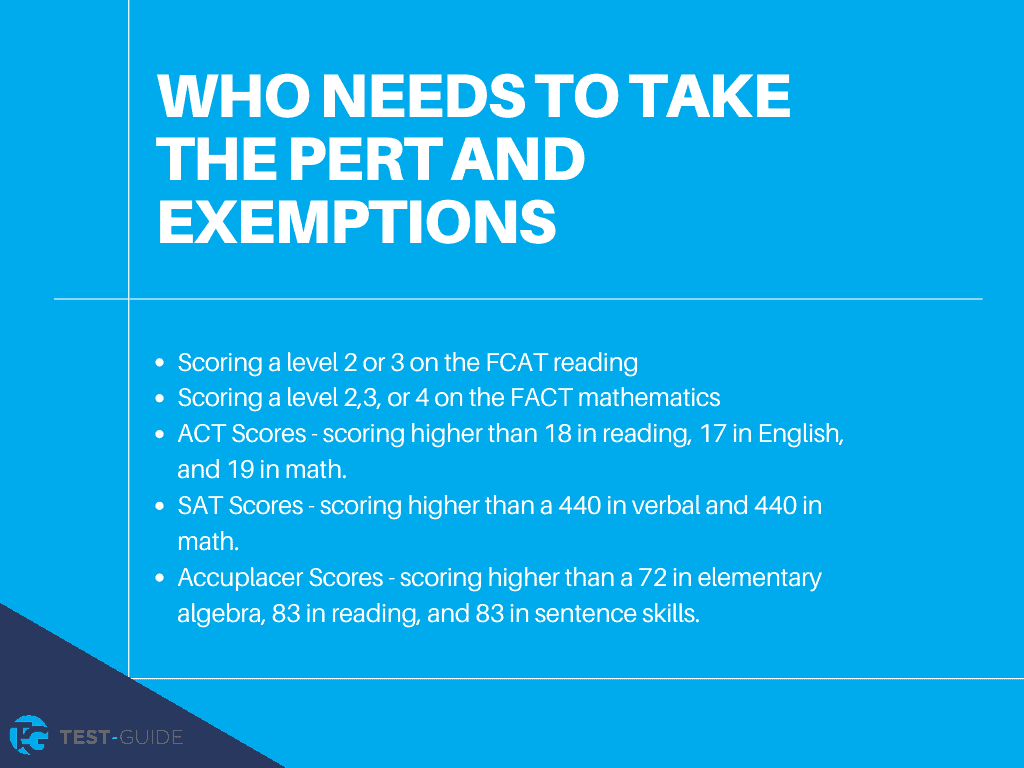All PERT Practice Tests
Take a PERT practice test below. We have split our exams up by category. Make sure to review the answer explanations at the end of each exam.
PERT Math
PERT Writing
- PERT Writing Practice Quiz 1
- PERT Writing Practice Quiz 2
- PERT Writing Practice Quiz 3
- PERT Writing Practice Quiz 4
PERT Reading
PERT Exam Overview
The Postsecondary Education Readiness Test (PERT) is an exam used by the state of Florida to ensure high school students are ready to take college-level courses.
Fast Facts:
- Number of Questions: 90 (30 Per Subject)
- Subjects Tested: Math, Reading, and Writing
- Time Limit: Untimed (Expect the Exam to Take About 3 Hours)
- Question Types: Multiple-Choice
The PERT exam is made up of 3 different sections – math, reading, and writing. Each section contains 30 questions and is untimed. The exam will take about 3 hours total.
In addition, the PERT is a computer adaptive exam. This means that the questions will adapt based on how you are performing. You may see easier or harder questions.
PERT Math
You will be tested on the following concepts in the PERT math section:
- Linear Equations
- Linear Equalities
- Quadratic Equations
- Literal Equations
- Evaluating Algebraic Expressions
- Factoring, Simplifying, Adding, Subtracting, Multiplying, and Dividing Polynomials
- Dividing Monomials and Binomials
- Standard Algorithms and Concepts
- Translating Between Lines and Inspecting Equations on a Coordinate Plane
- Focusing on Pairs in Linear Equations
You will be provided with an online calculator for the questions that allow for one.
PERT Reading
You will be tested on the following concepts in the PERT reading section:
- Summarizing the Main Ideas, Events, or Information
- Supporting and/or Disputing Points Made About The Passages
- Understanding the Meanings of Phrases
- Evaluating the Structure, Tone, Meanings, and Word Choices
- Figuring out the Author’s Purpose
- Interpreting Relationship Between Sentences
- Recognizing the Differences Between Facts and Opinions
- Evaluating the Reasoning of an Argument
PERT Writing
You will be tested on the following concepts in the PERT writing section:
- Recognizing Incorrect Shifts In Verb Tense and Pronouns
- Utilizing Proper Adjectives, Adverbs, and Case Forms
- Using Sentence Modifiers Correctly
- Determining Proper Parallel Structures
- Evaluating And Maintaining Style And Tone
- Applying Appropriate Grammar, Usage, and Mechanics According to Standard Written English
- Evaluating Data, Conclusions, and Opinions of Others
For additional information on the exam, here is the official PDF.
Who Needs to Take the PERT and Exemptions
All incoming college students in Florida are required to take the PERT in 11th grade unless they are exempt.
The most common PERT exemptions are granted for:
- FCAT Reading: Scoring a level 2 or 3 on the FCAT reading
- FCAT Math: Scoring a level 2,3, or 4 on the FCAT mathematics
- ACT Scores: Scoring higher than a 18 in reading, 17 in English, and 19 in math.
- SAT Scores: Scoring higher than a 440 in verbal and 440 in math.
- Accuplacer Scores: scoring higher than a 72 in elementary algebra, 83 in reading, and 83 in sentence skills.

PERT Scores
Each of the PERT subject tests are scored independently. The scores range from 50 to 150. Student’s can’t fail the PERT – the scores are used to determine what courses they should take in college.
Students must meet certain “cut” scores in each subject test in order to not be required to take developmental education or accelerated intervention coursework.
The cut scores are listed below:
PERT Math Cut Scores
- Lower Level Developmental Education: Scores from 50 to 95
- Higher Level Developmental Education: Scores from 96 to 112
- Intermediate Algebra (MAT 1033): Scores from 113 to 122
- College Algebra or higher (MAC 1105): Scores from 123 to 150
PERT Reading Cut Scores
- Lower Level Developmental Education: Scores from 50 to 83
- Higher Level Developmental Education: Scores from 84 to 103
- Freshman Composition Skills I (ENC 1101): Scores from 104 to 150
PERT Writing Cut Scores
- Lower Level Developmental Education: Scores from 50 to 89
- Higher Level Developmental Education: Scores from 90 to 98
- Freshman Composition Skills I (ENC 1101): Scores from 99 to 150
PERT Practice Test Benefits
There are many benefits of using a PERT practice test to prepare for your exam. Some of those benefits include:
- Improving Your Problem Solving Abilities: To do well on the PERT exam, especially the math section, you need to be able to solve problems. As you practice with our sample questions, and review the provided explanations, you will increase your ability to solve problems.
- Mastering the Test Format: Standardized exams, like the PERT, have their own particular test formats. The best way to become familiar with the test format is to take practice exams. By understanding the PERT test format you will have no surprises on test day!
- Concentrating Your Study: Many students waste a lot of valuable study time by reviewing material that they are good at. As you take more and more sample tests you begin to get a feel for the topics that you know well and the areas that you are weak on. The most effective way to study is to concentrate on the areas that you need help on.
Frequently Asked Questions
How many questions are on the PERT?
You will be tested on 90 questions on the PERT. There are 30 questions per subject (math, reading, and writing).
What is on the PERT?
The PERT has 3 different categories:
- Math
- Reading
- Writing
How long is the PERT?
The PERT exam is untimed. You can expect the exam to take about 3 hours to complete.
How do PERT scores work?
Each subject on the PERT is scored separately from the other categories. The scores can range from 0 to 150. Students cannot fail the PERT, the scores are used to determine which classes they should be in.

